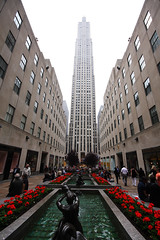By 1930, Mexican muralist Diego Rivera has gained international favor for his lush and passionate murals, says PBS.org. Inspired by Communist ideals and an intense devotion to his cultural heritage, Rivera creates boldly hued masterpieces of public art that adorn the municipal buildings of Mexico City.
His outgoing personality puts him at the center of a circle of left-wing painters and poets, and his talent attracts wealthy patrons, including Abby Aldrich Rockefeller. In 1932, she convinces her husband, John D. Rockefeller, Jr., to commission a Rivera mural for the lobby of the soon-to-be-completed Rockefeller Center in New York City.
Flush from successes in San Francisco and Detroit, Rivera proposes a 63-foot-long portrait of workers facing symbolic crossroads of industry, science, socialism, and capitalism. The painter believes that his friendship with the Rockefeller family will allow him to insert an unapproved representation of Soviet leader Vladimir Lenin into a section portraying a May Day parade.
The real decision-making power lies with the Center's building managers, who abhor Rivera's propagandistic approach. Horrified by newspaper articles attacking the mural's anti-capitalist ideology, they order Rivera to remove the offending image.
When Rivera refuses, offering to balance the work with a portrait of Abraham Lincoln on the opposing side, the managers pay his full fee, bar him from the site, and hide the mural behind a massive drape.
Despite negotiations to transfer the work to the Museum of Modern Art and demonstrations by Rivera supporters, near midnight, on February 10th, 1934, Rockefeller Center workmen, carrying axes, demolish the mural.
Later, Rivera recreates the frescoes in the Palace of Fine Arts in Mexico City, adding a portrait of John D. Rockefeller, Jr., in a nightclub. Rivera never works in the United States again, but continues to be active, both politically and artistically, until his death in 1957.
Thursday, August 16, 2012
Subscribe to:
Post Comments (Atom)





No comments:
Post a Comment